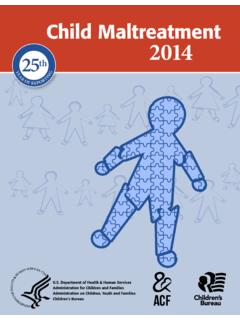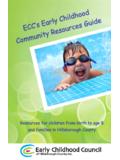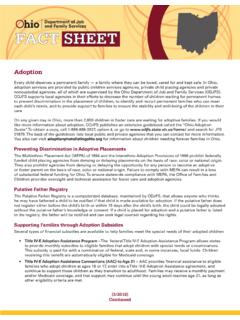Transcription of Assessing Children in Need and their Families
1 Assessing Children in Need and their Families :Practice GuidanceDepartment of HealthAssessing Children in Need and their Families :Practice Guidance LondonThe Stationery OfficeSocial Care GroupThe Social Care Group is one of the four business groups in the department of Health. Itis jointly headed by the Chief Social Services Inspector and the Head of Social Care supports Ministers in promoting high quality, cost effective services through national policies support to external social care agencies inspectionThe Social Services Inspectorate is a part of the Social Care Group. It is headed by theChief Social Services Inspector who is the principal professional advisor to Ministers onsocial services and related AccessThis document is available on the DoH internet web site at: publication is also available on The Stationery Office website Stationery Office site contains the document in a fully searchable format togetherwith links to related publications referenced in the text.
2 The data is held on a secure sitethat is password protected so you will need the following information to access it:User name: pgacneedPassword:r5ch8rdPlease note that both fields are case sensitive and contain no spaces. Crown copyright 2000 First published 2000 Published with permission of the department of Health on behalf of the Controller of Her Majesty s Stationery 011 322418 0 Published by The Stationery Office LtdApplications for reproduction should be made in writing to:The Copyright UnitHer Majesty s Stationery OfficeSt Clements House2 16 ColegateNorwich NR3 1 BQPrinted in the United Kingdom for The Stationery OfficeJ ?????? c??? ??/2000 ForewordixIntroductionxi1 Knowledge underpinning the Assessment Framework 1 Wendy Rose and Jane is meant by knowledge in this importance of Protective factors and Children s Parental Parents Theories and myths of the individual in Wider family.
3 Community and environmental Overarching theories and approaches that inform Methods of Roles and tasks of child and family The challenge of evidence based work20 Appendix 1 Chart illustrating the developmental progress of infants and23young childrenAppendix 2 Genogram29 Appendix 3 Ecomap30 References312 Assessing black Children in need and their families37 Ratna Dutt OBE and Melanie black Children in need and their Socio economic The changing nature of culture for England s black population39 Key issues in current child welfare Numbers of black Children in Family Inquiry Reports40 THEORIES AND PRACTICE INFORMING ASSESSMENT41 Domain: Children s Developmental and Emotional and Behavioural nature of and personal development of a racial , religious and linguistic aquisition of cultural Presentation and Selfcare and Social Relationships51 Domain: Parenting Racial abuse and Emotional Guidance, Boundaries and Stability60 Domain: Family and Environmental Factors62 Family History and Family Family structure and Parenting strengths and Wider Families Social Community Resources68 References703 Assessing the needs of disabled Children and their families73 Ruth Marchant and Mary Children and the Assessment Disabled Children and Using assessments positively with disabled Children and young people76 Domain: Child s Developmental of health and Behavioural and Social : Parenting and.
4 Family and Environmental Family History and Wider Family Social Community Involving Children in the assessment Conclusion103 Appendix 4 Definitions of Disability and Key Legislation104 References108vii4 Resources to assist effective assessment of Children in collection and recording of commissioned to assist the assessment underpinning the use of practice Use of questionnaires and scales in Evidence based Training resources122 References127viiiixThis publication is a companion volume to the Guidance on the Framework for theAssessment of Children in Need and their Families . It is a significant contribution to amajor programme of work led by the department of Health to provide guidance,practice materials and training resources on Assessing Children in need and theirfamilies. This is to assist in the achievement of one of the government s key policyobjectives in Children s services, delivered through the Quality Protects Programme, to ensure that referral and assessment processes discriminate effectively betweendifferent types and level of need, and produce a timely government policy objectives may be clear, effective implementation requiresdetailed knowledge and understanding.
5 The practice guidance has been produced to help policy makers, managers and practitioners who have responsibility forresponding to the needs of some of our most disadvantaged and vulnerable needs of some Children require particular knowledge and sensitivity to ensurethey do not suffer further disadvantage. These include Children from black andminority ethnic Families and disabled Children . The issues involved in Assessing theirneeds within the context of their Families and communities are discussed by leadingprofessionals in their field. The steering and advisory groups, which were set up todevelop the Guidance on the Assessment Framework, have contributed to is hoped this publication will be a valuable resource for use in promoting evidence-based practice, not only in direct work with Children and Families but also in trainingand continuing staff HuttonMINISTER OF STATE FOR SOCIAL SERVICESM arch 2000 ForewordxiThe body of knowledge available to those who struggle with today s problems ofchild care is still rudimentary compared with the physical sciences; but it is by farand away greater than what could called upon in the Indeed, social worktoday is expected to be evidence-based , something that would have been anunrealistic aspiration in, say, the 1950s, when there was virtually no evidence uponwhich to draw (Parker, 1999, 55).
6 Understanding what is happening to a child when there are concerns that the child shealth and development are being impaired remains a core professional activity forthose working with Children and Families . The knowledge which is available to assistthem has expanded dramatically over the last two decades. However, it has not alwaysbeen easily available to practitioners and their managers. The development of theFramework for the Assessment of Children in Need and their Families (jointly issued bythe department of Health, the department for Education and Employment and theHome Office, 2000) has drawn heavily, from many disciplines, on the wealth ofresearch and accumulated practice experience about the developmental needs ofchildren. The aim of the practice guidance in this accompanying publication is tomake transparent the evidence base for the Assessment Framework, thereby assistingprofessionals in their tasks of analysis, judgement and decision 1 highlights some of the key theories, research findings and practice wisdomwhich have underpinned the development of the Assessment Framework and inwhich confidence can be placed.
7 Staff who are working with Children and Families mayfind further exploration of the texts referenced in this chapter helpful in informingtheir practice. Chapter 2 provides more specific knowledge and guidance aboutworking with black Children and their Families and points to useful sources ofinformation. Chapter 3 similarly provides knowledge and guidance about assessingthe needs of disabled Children and their Families . These two chapters address issues ofmajor importance which must be integral to policy, planning, management andpractice in work with Children and Families . However, the messages which can bedrawn from these two chapters can be used in work with department of Health is grateful to the authors of the chapters:Chapter 1: Wendy Rose, Senior Research Fellow and Jane Aldgate, Professor ofSocial Care, The Open UniversityIntroductionChapter 2: Ratna Dutt OBE, Director, REU and Melanie Phillips, Researcher, Trainer and Consultant to REUC hapter 3: Ruth Marchant and Mary Jones, Directors of TriangleThe concluding chapter, Chapter 4, outlines a significant package of department ofHealth commissioned resources which can be used to support staff in their practiceand in their professional development.
8 These resources include texts summarising keymessages from relevant research findings, questionnaires and scales to assist work withchildren and Families , training materials and other work under are only a selection of what is available. Knowledge is continually being updatedand important developments will take place over the next few years. It is, therefore,incumbent on all professionals involved in training, management and practice to becontinually alert to new resources, to ensure that work with Children and Families isfirmly evidence-based. Through the department of Health s Quality ProtectsProgramme, an important process of change is underway aimed at improving theoutcomes for Children in need. The development of the Framework for the Assessmentof Children in Need and their Familiesand its associated materials forms a significantpart of this GraySOCIAL CARE GROUPDEPARTMENT OF HEALTHREFERENCESD epartment of Health, department for Education and Employment and Home Office (2000)Framework for the Assessment of Children in Need and their Families .
9 Stationery Office, B, Parker R and Utting W (1999) Reshaping Child Care Practice. NISW, is meant by knowledge in this the Framework for the Assessment of Children in Need and their Families ( department of Health et al, 2000) to which this practice guidance relates, it has beenemphasised that the framework is grounded in knowledge. Knowledge is defined astheory, research findings and practice experience in which confidence can be placed toassist in the gathering of information, its analysis and the choice of intervention informulating the child s chapter explores how theory, research and practice assist in understanding each ofthe three domains or systems of the framework and their interaction, the roles andtasks of the child and family worker, the processes of planning and decision makingand the importance of evidence based are many theories from a range of disciplines which contribute to theunderstanding of human growth and development and the interaction betweeninternal and external factors which have an impact on the lives of (1998, ) summarises the importance of the interplay of these factorswhich can be applied to the Assessment Framework.
10 Social workers need a framework for understanding and helping Children andfamilies which takes into account the inner world of the self and the outer world ofthe environment, both in terms of relationships and in terms of practicalities such ashousing. It is the capacity of social workers to be aware of and integrate in their practice these different areas of concern which defines the distinctive nature of theirprofessional Chapter 2 of the Guidance on the Assessment Framework ( department of Healthet al, 2000), the three domains of child s developmental needs, parenting capacity andfamily and environmental factors are described (Figure 1). These domains and theirinterrelationship take account of the inner world of the self and the outer world of theenvironment (Schofield, 1998). Child has long been recognised that Children develop along several dimensions, oftensimultaneously, and that they need to reach a series of milestones along eachdimension if optimal outcomes are to be achieved.















